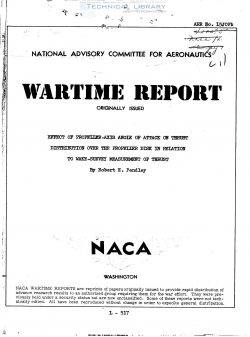naca-wr-l-517
- Version
- 189 Downloads
- 1.18 MB File Size
- 1 File Count
- April 2, 2017 Create Date
- April 2, 2017 Last Updated
Effect of Propeller Axis Angle of Attack on Thrust Distribution Over the Propeller Disk in Relation to Wake Survey Measurement of Thrust

I By Robert E. Pendley
SUMMARY
Tests were made to investigate the variation of
thrust distribution over the propeller disk with angle
of pitch of the propeller thrust axis and to determine
the disposition and the minimum number of rakes neces—
sary to measure the propeller thrust. The tests were
made at a low Mach number for a low and a high blade
angle with the propeller operating at three small angles
of pitch, and some of the tests were repeated at a higher
Mach number. The data obtained show that, for small
angles of pitch, large changes occur in the energy distri-
bution in the wake which prohibit the use of a single
survey rake for thrust measurement in flight tests and
limit the use of a single rake in wind-tunnel tests.
Under certain conditions, the energy distribution in the
wake took on a symmetrical form and two diametrically
opposed survey rakes were shown to be satisfactory for
obtaining propeller thrust.
INTRODUCTION
In many cases a total—pressure survey rake is a
more desirable means for measuring propeller thrust than
a force system because not only the total thrust can be
obtained.from wake-survey data but a130 the action of the
elements along the propeller blade can be analyzed. In
flight tests propeller thrust can be measured only by
wake surveys since a satisfactory thrust meter has not
yet been develOped. In wind-tunnel investigations of
propellers, however, the thrust obtained by use of a force
system often differs considerably from that obtained by
single-rake wake-survey measurements.
2 ., .. _.._NAcsAnnNo.L5m2b
- .
'l .' . -. 1'
In reference 1 the lack of agreement between the
thrust obtained by wake surveys and by force tests was
explained as the result of huh drag.and increase in body
drag due to the slipstream. In reference 2, published
later, propeller-thrust-axis inclination to the free-
stream flow was shown to affect wake-survey measurements
since large variations in the distribution of thrust
over the propeller disk were found to occur with varia-
tions in angle of pitch or yaw. Some of the lack of
agreement in the measurements of reference 1 might
therefore have been caused by a small angle of pitch or
yaw of the propeller thrust axis, although the hub drag
and the increase in body drag undoubtedly contributed to
the lack of agreement. The effect of propeller-thrust-
axis inclination to the free-stream flow on wake—survey
measurements was further verified by tests made in the
Langley 8~foot high-speed tunnel. In these tests, large
differences in the thrust measured by a force system and
by a single survey rake were found with the model at an
angle of attack of 1°, but excellent agreement was
obtained when the tests were made at an angle of
attack of 0°.
The present tests were made in the Langley 8-foot
high-speed tunnel to investigate the variation of thrust
distribution over the propeller disk with angle of pitch
of the propeller thrust axis and'to determine the number
and radial position of_wake—survey rakes necessary to
obtain the propeller thrust. Survey measurements with
a single rake were made at six equally spaced radial
positions around the propeller disk. The tests were
made at three small angles of attack of the propeller
thrust axis for a high and a low blade angle and at
two Mach numbers. The effect of longitudinal position
of the rake was not investigated.
| File | Action |
|---|---|
| naca-wr-l-517 Effect of Propeller Axis Angle of Attack on Thrust Distribution Over the Propeller Disk in Relation to Wake Survey Measurement of Thrust.pdf | Download |

Comment On This Post